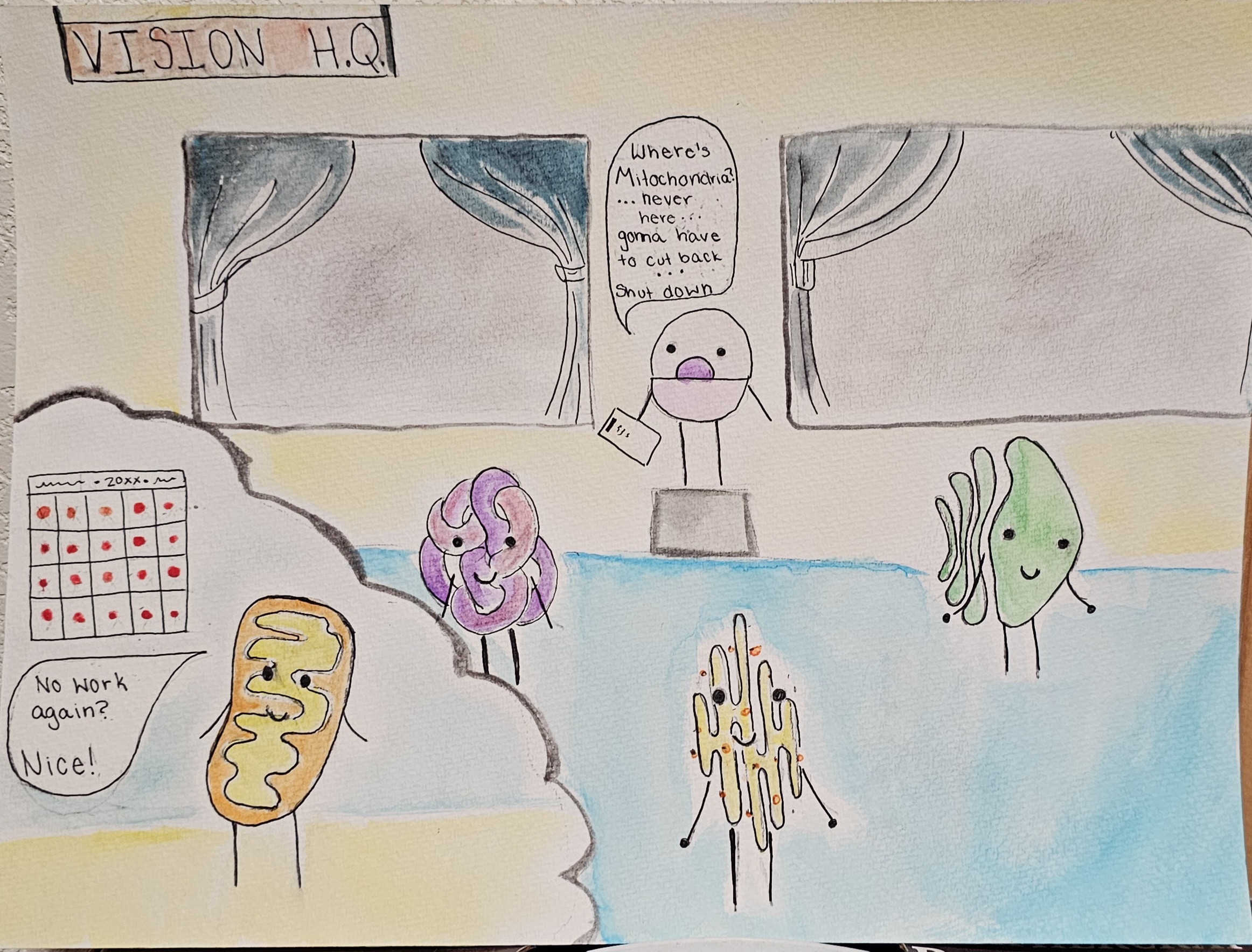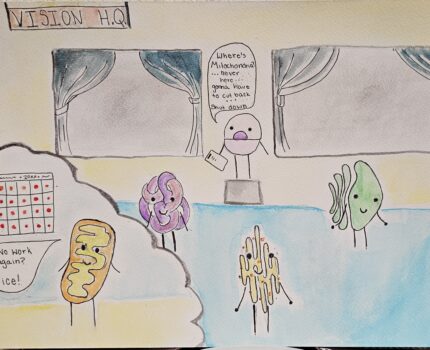The objective I am covering is organelles and their functions. In this project I focused on one specific organelle -mitochondria- and a disease that impacted its function. Leber hereditary optic neuropathy or LHON is a mitochondrial disorder. Mitochondrial disorders are a family of disorders stemming from mitochondria (the organelle whose function is to provide energy for the cell) that don’t produce enough energy, leading to cell death, and tissue and organ dysfunction.
My piece is a drawing/ comic from within the tissues in the eyes, and demonstrates a situation which leads to the eyes not functioning. It has two views, one of the mitochondria and another of the cell and rest of the organelles. In the picture we can see that all the organelles, such as the Golgi body and Nucleus have shown up to work, but that mitochondria is not doing its work like it should, even though they need it to be working. This is remarked upon by the supervisor who comments that without mitochondria working they will be shut down. From mitochondria’s perspective we can see a schedule or calendar that indicates that mitochondria does not need to work that day.
- LHON impacts the eyes, within the optic nerve which is why I put a sign identifying the location of my drawing as “Vision H.Q.”.
- With this version of a mitochondria disease, the mitochondria of the eye within the retinal ganglion cells specifically are impacted (Carelli et al., 2023). These cells are incredibly sensitive to mitochondrial deficiencies and once they stop functioning vision is quickly lost. The average time of onset to impairment in both eyes is 6-8 weeks, and the typical level of deterioration reduces a patient to 20/200 vision- or legally blind, (Meyerson et al., 2015)
- This is shown in my drawing/ comic with the ‘supervisor’ mentioning they might get shut down without Mitochondria there. Not only does the process simply become impaired, it progresses so much it essentially can’t function.
- Mitochondria are different from many other organelles in that they have their own DNA which is separate from the cell they inhibit. This means there can be errors in mitochondrial DNA (mtDNA) that don’t affect the other organelles (coded from nuclear DNA) (Meyerson et al., 2015). This mtDNA is also only passed down from the mother.
- This is why all the other organelle are present at the job, they still are receiving the correct info to tell them to be there.
- The Mitochondria not producing energy stems from several possible mutations in the mitochondrial DNA (not the nuclear DNA) that usually contains the instructions for oxidative phosphorylation, which is needed to produce ATP. However many of the instructions are still coded in the Nuclear DNA so the entire function is not lost (Meyerson et al., 2015).
- This is represented by having the ‘supervisor’ and the mitochondria with two different copies of the schedule, and Mitochondria’s indicates that he does not need to go to work, his instructions don’t tell him to function. Mitochondria still exist but they do not work properly.
- The Mutation for LHON specifically is found on the nucleotide points 3460, 11778, and 14484 in the majority of patients. These all affect the respiratory chain in complex 1 (Meyerson et al., 2015). Respiratory complex 1 oxidizes NADH, and is both physically and literally a large part of the respiratory chain (Sharma et al., 2009).
References
Carelli, V., La Morgia, C., & Yu-Wei-Man, P. (2023). Mitochondrial optic neuropathies. PubMed. Retrieved November 20, 2024, from https://pubmed.ncbi.nlm.nih.gov/36813316/
Meyerson, C., Van Stavern, G., & McClellan, C. (2015). Leber hereditary optic neuropathy: current perspectives. Clinical Ophthalmology.
Sharma, L., Lu, J., & Bai, Y. (2009). Mitochondrial Respiratory Complex I: Structure, Function and Implication in Human Diseases. Current medicinal chemistry, 16(10). https://pmc.ncbi.nlm.nih.gov/articles/PMC4706149/#:~:text=Complex%20I%20is%20the%20first,individual%20subunits%20are%20largely%20unclear.


This project covers a specific disorder of the mitochondria – Leber’s hereditary optic neuropathy. The disorder can lead to cell death and ultimately cause visual impairment, due to the malfunctioning of the mitochondria. The mitochondria do not produce enough energy in this disorder (LHON), and they behave this way because of an inherited genetic mutation in the mitochondrial DNA (from the mother’s side), that causes the mitochondria to not have the instructions it needs to appropriately function. As a result of these missing instructions, the mitochondria does not get the ATP it needs to perform, due to the mutation affecting the respiratory chain, and causing the oxidative phosphorylation to not occur, which produces the ATP. The location of the mutation in the mitochondrial dna causes the downstream effects which ultimately cause the dysfunction of the mitochondria in the retinal ganglion cells and the eventual loss of vision. The impact on vision can occur within 6-8 weeks after the onset of the disorder process, and this results in legal blindness. The artwork for this essay helps the reader understand how the different components of the cell are supposed to work together for healthy function, and how when the mitochondria does not preform its role, the entire chain of productivity in the cell is impacted and appropriate function cannot occur. Understanding the mechanisms of this disease could assist with helping the public be aware of this condition, help patients understand and request information about genetic predisposition for their own healthcare, and open the door to explore possible treatment options in the future.